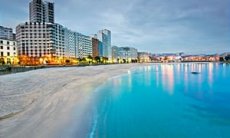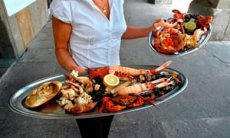la coruna Spain
 Playa de Orzan in La Coruña, Spain. Photographs: Alamy
Playa de Orzan in La Coruña, Spain. Photographs: Alamy
Often-overlooked La Coruña in northern Spain is just the place to find good food, fabulous beaches and a dash of culture
"La Coruña is one long sea front, " said my taxi driver as we rounded the headland towards Riazor, the huge urban beach that is the major natural feature of this northern Spanish city. On the sand, surfers were polishing their boards and pale-skinned families, enjoying the sudden Atlantic summer, were energetically doing what families do on beaches.
From my hotel, I could see the crouching form of Riazor stadium, home of Deportivo La Coruña ("el Depor") and one of Spain's cathedrals of football. And at the end of the beach, the new Museo Nacional de Ciencia y Tecnología (Muncyt), glittering in the afternoon sun. The museum, opened in May, is a masterpiece of take-no-prisoners modernism by architects Victoria Acebo and Angel Alonso, and the city's most talked-about new attraction. Outwardly it is a stunning concatenation of glass and concrete; inwardly, it's an engaging attempt to make Spain feel good about its technological heritage.
 La Coruña is hardly a great techno-metropolis, but it has the big-town brashness of a place that still lives mainly on manufacturing. It also has the bracing saltiness of a harbour city, and a Brighton-like feel in the bric-a-brac and street-fashion shops of the grungy Orzán district behind Riazor beach. For centuries it lived under the long shadow of Santiago de Compostela, whose clerical pomp and cultural dominion it fiercely resented. But La Coruña is fighting back. For two summers (in 2010 and 2011) it hosted a satellite version of Barcelona's Sónar festival, capitalising on the busy local club scene. Now the city is hoping that the Muncyt will put it on the map, Guggenheim-style, as an exhilarating and original short-break destination.
La Coruña is hardly a great techno-metropolis, but it has the big-town brashness of a place that still lives mainly on manufacturing. It also has the bracing saltiness of a harbour city, and a Brighton-like feel in the bric-a-brac and street-fashion shops of the grungy Orzán district behind Riazor beach. For centuries it lived under the long shadow of Santiago de Compostela, whose clerical pomp and cultural dominion it fiercely resented. But La Coruña is fighting back. For two summers (in 2010 and 2011) it hosted a satellite version of Barcelona's Sónar festival, capitalising on the busy local club scene. Now the city is hoping that the Muncyt will put it on the map, Guggenheim-style, as an exhilarating and original short-break destination.
Shellfish supper in La Coruña
As night fell I set out for Calle Estrella, La Coruña's prime tapas territory. It was Monday, but the bars on Estrella were heaving, the mild July night filling the terrace tables with good-natured, raucous crowds. At Cunqueiro, a cheery old tavern with slate floors and stone walls, I ate a first-night supper of octopus with potatoes (pulpo á feira) accompanied by a glass of Albariño. It felt like a culinary "welcome to Galicia".
El Depor recently won promotion from the Spanish second division, but in gastronomic terms La Coruña is always in the primera liga. From the cheap-as-chips tascas of Calle Barrera, where locals go for china bowls of Ribeiro wine and platters of winkles, to top-end marisquerías (shellfish joints) and restaurantes de autor (chef-driven restaurants) such as Domus and Alborada, there is quality at every level.
The city is handsome yet somehow rough-hewn, with islands of gentrification around Plaza de Lugo, where a decorative modernista style adorns the facades of early-20th-century mansion blocks, and the picture-pretty medieval Ciudad Vieja.
Source: www.theguardian.com
Related posts:








